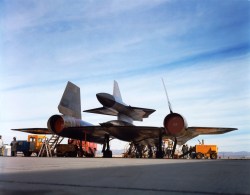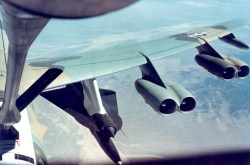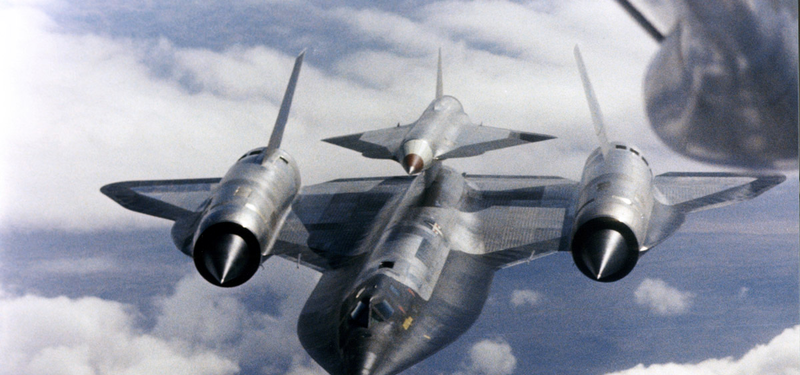What looks like something famous, is much smaller, and is embroiled in a web of cold war cloak-and-dagger intrigue? It sounds like the answer could be Mini-Me from the Austin Powers movies, but we were actually thinking of the D-21 supersonic spy drone. Never heard of it? It didn’t have a very long service life, but it was a tiny little unmanned SR-71 and is part of a spy story that would fit right in with James Bond, if not Austin Powers.
The little plane had a wingspan of only 19 feet — compared to the SR-71’s 56 foot span — and was 42 feet long. It could fly at about Mach 3.3 at 95,000 feet and had a range of around 3,500 miles. It shared many characteristics with its big brother including the use of titanium and a design to present a low RADAR cross-section.
The Spy Who Photographed Me
With today’s global economy and increased international cooperation, it is hard to remember just how tense the late 1960s were. Governments wanted to see what other governments were up to. Satellite technology would eventually fill that role, but even though spy satellites first appeared in 1959, they used film that had to be retrieved by an airplane as it fell from the sky and then processed. Not exactly real time. More effective satellites would have to wait for better imaging technology — see the video below for just how bad those old satellite images were. That left spy planes to do the bulk of the work.
https://www.youtube.com/watch?v=q7wGwiFsIRI
The problem with spy planes is they can get shot down. This happened famously when Gary Powers was shot down while flying a U-2 over Russia. The best answer to that is getting higher than your adversary can shoot — and that’s the basic genesis of the famous SR-71 by Lockheed. However, Lockheed proposed several answers, including the D-21. This spy plane had no crew, so while having it shot down — as unlikely as that was — would have been embarrassing, it wouldn’t be as bad as having a pilot on the news confessing to espionage.
The Little Plane that Couldn’t
 There were 38 D-21’s built. Lockheed skunkworks was responsible, so it is not surprising the craft looks a bit like a tiny SR-71 with swept back delta wings. In fact, the original plan was to launch the plane from a modified SR-71. The plane would streak over its target taking pictures, eject a film bucket — much like a satellite does — and then self destruct. A plane would either snag the film bucket or it could be recovered at sea by a ship.
There were 38 D-21’s built. Lockheed skunkworks was responsible, so it is not surprising the craft looks a bit like a tiny SR-71 with swept back delta wings. In fact, the original plan was to launch the plane from a modified SR-71. The plane would streak over its target taking pictures, eject a film bucket — much like a satellite does — and then self destruct. A plane would either snag the film bucket or it could be recovered at sea by a ship.
In 1962, a full-scale mockup was ready, known as the Q-12. The CIA wasn’t very interested, but the air force wanted it not only as a spy plane but as a cruise missile. The 1964 initial tests carrying the thing aloft on a mothership were not promising. At first, the D-21 had aerodynamic covers put on its engines to reduce drag. They found there was no safe way to remove them at Mach 3, so they had to stop flying with the covers.
By 1966 they were trying to actually test launch the D-21. Flying at over Mach 3 at 90,000 feet, the plane was plagued with issues. A hydraulic pump failure took one plane. Another flight was successful, but the film bucket failed to eject.
It was the fourth launch that would convince Lockheed to stop launching from a modified SR-71. The video below shows disturbing footage of the result. The previous launches had the host aircraft make a loop to help separate the two craft. This time they tried from a straight and level flight path. The D-21 had an engine failure which caused it to strike the tail of the SR-71 host. The two crew ejected over the ocean, and the launch control officer, Ray Torrick, drowned before recovery.
https://www.youtube.com/watch?v=GMyC2urCl_4
The B-52s
 This caused two major changes to the D-21 program. First, a solid rocket booster would push the plane off its carrier. Second, the carrier was to be a Boeing B-52 bomber. The drone would now attach from the top with the bottom carrying the rocket booster which was actually larger than the D-21 (now known as the D-21B).
This caused two major changes to the D-21 program. First, a solid rocket booster would push the plane off its carrier. Second, the carrier was to be a Boeing B-52 bomber. The drone would now attach from the top with the bottom carrying the rocket booster which was actually larger than the D-21 (now known as the D-21B).
These changes didn’t do much to change the drone’s luck. The first attempted launch in 1967 saw the drone fall off the carrier early due to a stripped nut. It would take five more attempts before there was a completely successful flight. Of the next five flights, two would be unsuccessful.
Operations
By late 1969, the D-21 started its brief operational life. The mission: spy on the Chinese nuclear test site at Lop Nor. The plan was the planes would launch from Guam, fly over Lop Nor, turn around, and fly back over the ocean to deliver the film and self destruct.
 The first mission failed to turn and crashed in the Soviet Union. The second mission worked better but had a fault when trying to eject its film. While the third time was the charm for the D-21, the crew retrieving the film couldn’t say as much. The plane that should have snagged the film bucket in mid-air missed. The Navy destroyer sent to retrieve it in the ocean instead ran it over and the film sunk to the bottom of the ocean. The fourth, and mercifully final, flight crashed over China where it languished for years in a junkyard before going on exhibit at the China Aviation Museum.
The first mission failed to turn and crashed in the Soviet Union. The second mission worked better but had a fault when trying to eject its film. While the third time was the charm for the D-21, the crew retrieving the film couldn’t say as much. The plane that should have snagged the film bucket in mid-air missed. The Navy destroyer sent to retrieve it in the ocean instead ran it over and the film sunk to the bottom of the ocean. The fourth, and mercifully final, flight crashed over China where it languished for years in a junkyard before going on exhibit at the China Aviation Museum.
By July 1971, the program was done. Satellite imaging was getting better and Nixon had been to China. Of the 38 built, 17 remain in storage at the Air Force boneyard. However, the really interesting thing is what happened to that very first lost D-21.
The Sincerest Form of Flattery
That first operational flight crashed in what might have been the worst possible place from the United State’s perspective: the Soviet Union. As you might expect, the Soviets gathered up the wreckage and studied it.
The Tupolev Experimental Design Bureau opened project Voron to produce an imitation of the D21. It never flew, but the work provided valuable insights on materials and techniques for supersonic aircraft and missiles. However, by the time Voron would be something to build, the Soviets, too, were betting on spy satellites.
Spy vs Spy
It is amazing how much expense and trouble governments will go through to spy on each other. Of course, all of this was highly classified in its own time. Corona — the first spy satellites — were classified until 1995. Many of the D-21 records were classified until late last year. The last link on that page has some great pictures that are poorly scanned. There are other interesting tidbits including directions on how to deal with public sightings or a crash that is visible to the public.
We always find it interesting to catch up on recently declassified material, especially when it is high tech. Did you know the US stole a Soviet moon lander? But don’t worry, the Russians stole one from the US, too.
Photo credits:
All photos are public domain except for:
D-21 wreck in Chinese Aviation Museum by [N Ezov], CC-BY-SA-4.0.

















reminds me the XR-7 Thunder Dart project I heard some years ago:
http://www.hyperscale.com/2013/galleries/xr772pd_1.htm
But XR-7 was planned to be an piloted aircraft.
The XR-7 Thunderdart was a fictional aircraft designed by the Testor’s model company in 1/72 scale. That’s much too small to put real pilots on board. What is this? An airplane made for ants?
” Ray Torrick ”
You can’t invent this name :-D
Survived by his twin brother, Rhett.
Well someone invented the name.
Well, anything was better than project Pluto…
Yes. One of the worst ideas in military history. The only weapon I have ever heard of that couldn’t even be tested because just flying the thing was nearly equivalent to declaring nuclear war.
Engine was tested. Actual cruise missile? Nope.
https://en.wikipedia.org/wiki/Project_Pluto
“In fact, the original plan was to launch the plane from a modified SR-71. ”
In fact, the original plan was to launch the plan from an M-21, which like the Air Force’s SR-71 and YF-12A aircraft was a design variant based on the A-12 aircraft that Lockheed built for the CIA. It’s a pedantic point, but these were all unique purpose built aircraft under separate programs, not modifications made to an existing aircraft.
The only remaining MD-21 Blackbird can be seen at Seattle’s Museum of Flight. It’s pretty cool.
I’ve seen three. I think there are quite a few more. Wikipedia lists 13. Those might not all be MD21’s, but they are all D-21’s of some variety.
There is only one surviving M-21 Blackbird in the world. It is on display at the Museum of Flight. It has a D-21 mounted on its pylon.
In 1997 I visited New York, there is a aircraft carrier from the vietnam era on display that i visited.
I was surprised to find a MD-21 on the deck
Apparently, there are a dozen surviving examples on display:
https://en.wikipedia.org/wiki/Lockheed_D-21#Aircraft_on_display
Those are D-21 drones, not M-21 Blackbirds. The M-21 on display at Museum of Flight is the last of its kind. It also has a D-21 mounted on its pylon.
The M-21 was a purpose built aircraft for deploying the D-21 drones. Like the SR-71 and YF-12A, the M-21 is in the Blackbird family of aircraft which were based on the A-12 Oxcart design.
“It is amazing how much expense and trouble governments will go through to spy on each other. ”
Ever get that drone back from Iran?
https://www.bbc.com/news/world-us-canada-16095823
According to rumor about this, the only way the US public became aware of this program is some random person was wandering around the Montham Davis boneyard and found one sitting out in the open where anyone could see it, took some pictures, and people started asking questions. All this secrecy, and then they leave one where (at the time) any US citizen could walk in and look around.
I distinctly remember seeing one, dusty as hell, behind a chain-link fence at Pima Air & Space. It’s since been properly restored and moved into the SR71’s hangar.
Yeah, I was at Pima Air & Space museum April last year and saw it sitting under the wing of the SR71, looking in great condition. https://tinyurl.com/y2qf3jsc
That’s Davis-Monthan. And the boneyard facility is not open to the public in wuchxa way thatxanyone can just walk in and wander around. It’s still a high security facility. There are scheduled tours, but you have to stay on the bus. There are areas not toured by the bus, and there are more and less secured areas.
While it is probable that it was sitting out, in a secured area, it’s unlikely that it was some random civi taking a Sunday stroll and just stumbled over it.
Despite the Corona program being officially declassified in 1995, I had an old copy of Popular Science or Popular Mechanics from years earlier that detailed how the Corona system worked. One of those “Gee, I guess we should *officially* declassify this, since we already released the information 20 or more years ago.” things.
AMARC originally had all 13 surviving drones in their collection at the Davis Monthan boneyard
http://www.habu.org/lockheed/landis_D-21_Storage_At_DM_01.jpg
There are 13 off them on display.
AMARC at Davis Monthan originally had all 13 of them.
https://www.amarcexperience.com/ui/index.php?option=com_content&view=article&id=23&catid=8&Itemid=159
One has been fully restored is in the Pima Air Museum next door, but apparently at least one is still in boneyard(as off 2013)
https://www.gettyimages.com.au/detail/news-photo/lockheed-d-21-reconnoissance-drone-is-seen-with-other-news-photo/473575928
Still looking on Google maps trying to find it
It’s not there anymore.
You can still see it in Google maps https://www.google.com/maps/@32.15371,-110.84256,95m/data=!3m1!1e3
In Google Earth you can see it disappeared after August 2017
Google maps says that map was updated 2019
if anyone is interested the air museum at the Charles Schultz airport in northern California has a D21 (or at least did 2 years ago)